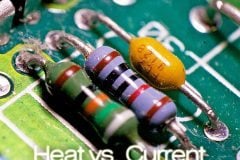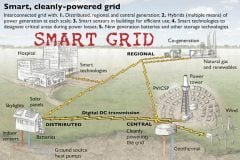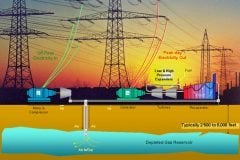
The problem of energy accessibility and production on Mars is one of the three main challenges for the upcoming colonisation of the red planet. The energetic potential on its turn is mainly dependent on the astrophysical characteristics of the planet. A short insight into the Mars environment is thus the compulsory introduction to the problem of energy onMars.
The present knowledge of the Martian environment is the result of more than two centuries of attentive observation on its astronomical appearance and, more recently, on its on-site astrophysical features. Recent surface measurements of Martian geology, meteorology and climate had fixed the sometime-unexpected image of a completely desert planet.
Mars is one of the most visible of the seven planets within the solar system and thus for its discovery cannot be dated, still the interest for Mars is old. It was easily observed from the ancient times by necked eye and the peculiar reddish glance of the planet had induced the common connection of the poor planet with the concept of war. The god of war and the planet that inherited his name had provoked, still from antiquity, curiosity and disputes on the most diverse themes. These disputes are at a maximum right now regarding the habitability of Mars.
The red planet owes his color to still unexplained causes, where a yet undisclosed chemistry of iron oxides seems to be the main actor. The visit card of Mars is fast increasing in the quantity of data and is now quite well known (Bizony, 1998), as we observe from the description that follows.
Mars as seen before the space age
As far as the knowledge of the solar system has gradually extended, from optical, ground-based observations to the present astrophysical research on site, Mars appears as the fourth planet as starting from the Sun. The reddish planet of the skies, nicely visible by necked eyes, has attracted the most numerous comments during the time regarding the presence of life on an extra terrestrial planet.
With all other eight planets, except for Pluto-Charondoublet, Mars aligns to a strange rule by orbiting the Sun at a distance that approximates amultiple of √2 from that of the Earth. This means that the rough 149.6 mil km of the Earth semi-major axis is followed by a rough 212 mil km for Mars. In fact there are 227.92 mil km at mean from the center of Sun. The power rule of Titius-Bode, modified several times, but originally described as a = (4 + 3 x sgn n x 2n-1) / 10 | n = 0,9 gives a better distribution.
Table 1. Mars within Titius-Bode’s rule (astronomical units)
| Planet | n | Titius-Bode rule | Actual semi-major axis |
| Mercury | 0 | 0.4 | 0.39 |
| Venus | 1 | 0.7 | 0.72 |
| Earth | 2 | 1.0 | 1.00 |
| Mars | 3 | 1.6 | 1.52 |
| Asteroids | 4 | 2.8 | 2.80 |
| Jupiter | 5 | 5.2 | 5.20 |
| Saturn | 6 | 10.0 | 9.54 |
| Uranus | 7 | 19.6 | 19.20 |
| Neptune/Pluto | 8 | 38.8 | 30.10/39.20 |
| Sedna | 9 | 77.2 | 75.00 |
It is immediately seen that the primary solar radiation flux is roughly two times smaller for Mars than it is for Earth. More precisely, this ratio is equal to 2.32. This observation for long has suggested that the climate on Mars is much colder than the one on Earth. This has not removed however the belief that the red planet could be inhabited by a superior civilization. Nevertheless, beginning with some over-optimistic allegations of Nicolas Camille Flammarion (Flamarion, 1862) and other disciples of the 19-th century, the planet Mars was for a century considered as presenting a sort of life, at least microbial if not superior at all. The rumor of Mars channels is still impressing human imagination.
When estimates begun to appear regarding the Martian atmosphere and figures like 50 mbar or 20 mbar for the air pressure on Martian ground were advanced (Jones 2008), a reluctant wave of disapproval has been produced. It was like everybody was hoping that Mars is a habitable planet, that we have brothers on other celestial bodies and the human kind is no more alone in the Universe. As more data were accumulating from spectroscopic observations, any line of emission or absorption on Mars surface was immediately related to possible existence of biological effects.
Even during the middle 20-th century the same manner was still preserving. In their book on “Life in the Universe” Oparin and Fesenkov are describing Mars in 1956 as still a potential place for biological manifestations (Oparin & Fesenkov, 1956).The following two excerpts from that book are relevant, regarding the claimed channels andbiological life on Mars: “…up to present no unanimous opinion about their nature is formed, although nobody questions that they represent real formations on the planet (Mars)…” and at the end of the book “On Mars, the necessary conditions for the appearance and the development of life were always harsher than on Earth. It is out of question that on thisplanet no type of superior form of vegetal or animal life could exist.
However, it is possiblefor life, in inferior forms, to exist there, although it does not manifest at a cosmic scale.
Reasons and costs for terraforming Mars
Thicken Mars’ atmosphere, and make it more like Earth’s. Earth’s atmosphere is about 78% Nitrogen and 21% Oxygen, and is about 140 times thicker than Mars’ atmosphere. Since Mars is so much smaller than Earth (about 53% of the Earth’s radius), all we’d have to do is bring about 20% of the Earth’s atmosphere over to Mars. If we did that, not only would Earth be relatively unaffected, but the Martian atmosphere, although it would be thin (since the force ofgravity on Mars is only about 40% of what it is on Earth), would be breathable, and about the equivalent consistency of breathing the air in Santa Fe, NM.
So that’s nice; breathing is good. Mars needs to be heated up, by a lot, to support Earth-like life. Mars is cold. Mars is damned cold. At night, in the winter, temperatures on Mars get down to about -160 degrees! (If you ask, “Celcius or Fahrenheit?”, the answer is first one, then the other.) But there’s an easy fix for this: add greenhouse gases. This has the effect of letting sunlight in, but preventing the heat from escaping. In order to keep Mars at about the same temperature as Earth, all we’d have to do is add enough Carbon Dioxide, Methane, and Water Vapor to Mars’ atmosphere.Want to know something neat? If we’re going to move 20% of our atmosphere over there, we may want to move 50% of our greenhouse gases with it, solving some of our environmental problems in the process.
These greenhouse gases would keep temperatures stable on Mars and would warm the planet enough to melt the ice caps, covering Mars with oceans. All we’d have to do then is bring some lifeforms over and, very quickly, they’d multiply and cover the Martian plane tin life. As we see on Earth, if you give life a suitable environment and the seeds forgrowth/regrowth, it fills it up very quickly. So the prospects for life on a planet with an Earth-like atmosphere, temperature ranges, and oceans are excellent. With oceans and an atmosphere, Mars wouldn’t be a red planet any longer.
It would turn blue like Earth! This would also be good for when the Sun heated up in several hundred million years, since Mars will still be habitable when the oceans on Earth boil. But there’s one problem, Mars has that Earth doesn’t, that could cause Mars to lose its atmosphere very quickly and go back to being the desert wasteland that it is right now: Mars doesn’t have a magnetic field to protect it from the Solar Wind.
The Earth’s magnetic field, sustained in our molten core, protects us from the Solar Wind. Mars needs to be given a magnetic field to shield it from the Solar Wind. This can be accomplished by either permanently magnetizing Mars, the same way you’d magnetize a block of iron to make a magnet, or by re-heating the core of Mars sufficiently to make the center of the planet molten.
In either case, this allows Mars to have its own magnetic field, shielding it from the Solar Wind (the same way Earth gets shielded by our magnetic field) and allowing it to keep its atmosphere, oceans, and any life we’ve placed there. But this doesn’t tell us how to accomplish these three things. The third one seems to us to be especially difficult, since it would take a tremendous amount of energy to do. Still, if you wanted to terraform Mars, simply these three steps would give you a habitable planet.
The hypothetical process of making another planet more Earth-like has been called terraforming, and terraforming Mars is a frequently mentioned possibility in terraforming discussions. To make Mars habitable to humans and earthly life, three major modifications arenecessary. First, the pressure of the atmosphere must be increased, as the pressure on the surface of Mars is only about 1/100th that of the Earth.
The atmosphere would also need the addition of oxygen. Second, the atmosphere must be kept warm. A warm atmosphere wouldmelt the large quantities of water ice on Mars, solving the third problem, the absence of water.
Terraforming Mars by building up its atmosphere could be initiated by raising the temperature, which would cause the planet’s vast CO2 ice reserves to sublime and become atmospheric gas.
The easiest way to raise the temperature seems to be by introducing large quantities of CFCs (chlorofluorocarbons, a highly effective greenhouse gas) into the atmosphere, which couldbe done by sending rockets filled with compressed CFCs on a collision course with Mars. After impact, the CFCs would drift throughout Mars’ atmosphere, causing a greenhouse effect,which would raise the temperature, leading CO2 to sublimate and further continuing thewarming and atmospheric buildup. The sublimation of gas would generate massive winds,which would kick up large quantities of dust particles, which would further heat the planet through direct absorption of the Sun’s rays. After a few years, the largest dust storms would subside, and the planet could become habitable to certain types of algae and bacteria, whichwould serve as the forerunners of all other life. In an environment without competitors and abundant in CO2, they would thrive. This would be the biggest step in terraforming Mars.
Conclusion
The problem of creating a sound source of energy on Mars is of main importance and related to the capacity of transportation from Earth to Mars, very limited in the early stages of Mars colonization, and to the capacity of producing the rough materials in situ. Consequently the most important parameter that will govern the choice for one or another means of producing energy will be the specific weight of the powerplant. Besides then uclear sources, that most probably will face major opposition for a large scale use, the onlyapplicable source that remains valid is the solar one. As far as the solar flux is almost fourtimes fainter on Mars than on Earth, the efficiency of PVC remains very doubtfull, although it stands as a primary candidate.
This is why the construction of the gravity assisted air accelerators looks like a potential solution, especially when rough materials will be availableon Mars surface itself. The thermal efficiency of the accelerator for producing a high power draught and the propulsion of a cold air turbine remains very high and attractive. The largearea of the solar reflector array is still one of the basic drawbacks of the system, that only could be managed by creating very light weight solar mirrors, but still very stiff to withstandthe winds on Mars surface.











Thanks